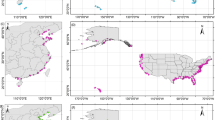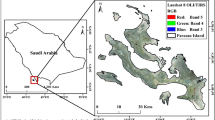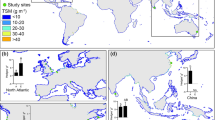Abstract
The coastal zone of China has experienced large increases in population, economy and urbanization since the early 1980s. Many studies have reported the loss, degradation and fragmentation of coastal wetlands in China at local to regional scales. To date, at the national scale, our knowledge of the spatial distribution, inter-annual variation and multi-decadal trends of coastal wetlands in China remains very limited. Here we analysed ~62,000 Landsat-5, -7 and -8 images over the period 1984–2018 and generated maps of coastal wetlands for individual years in China at 30-m spatial resolution. We found that coastal wetland area significantly decreased between 1984 and 2011. We also found a substantial increase in saltmarsh area and a stable trend of tidal flat area since 2012, driven by reduced anthropogenic activities and increased conservation and restoration efforts. These coastal wetland maps for the period 1984–2018 are invaluable for improvement of coastal wetland management and sustainability in China.
This is a preview of subscription content, access via your institution
Access options
Access Nature and 54 other Nature Portfolio journals
Get Nature+, our best-value online-access subscription
$29.99 / 30 days
cancel any time
Subscribe to this journal
Receive 12 digital issues and online access to articles
$119.00 per year
only $9.92 per issue
Buy this article
- Purchase on Springer Link
- Instant access to full article PDF
Prices may be subject to local taxes which are calculated during checkout





Similar content being viewed by others
Data availability
All datasets used in this study are publicly available online (Supplementary Table 7). The coastal wetlands maps are available from the corresponding author upon reasonable request and will be made available to the public. Source data are provided with this paper.
Code availability
The codes used in the calculations of coastal wetlands are available upon reasonable request.
References
Ma, Z. J. et al. Rethinking China’s new great wall. Science 346, 912–914 (2014).
Murray, N. J. et al. The global distribution and trajectory of tidal flats. Nature 565, 222–225 (2019).
Wang, X. et al. Tracking annual changes of coastal tidal flats in China during 1986–2016 through analyses of Landsat images with Google Earth Engine. Remote Sens. Environ. 238, 110987 (2020).
Blum, M. D. & Roberts, H. H. Drowning of the Mississippi Delta due to insufficient sediment supply and global sea-level rise. Nat. Geosci. 2, 488–491 (2009).
Murray, N. J., Clemens, R. S., Phinn, S. R., Possingham, H. P. & Fuller, R. A. Tracking the rapid loss of tidal wetlands in the Yellow Sea. Front. Ecol. Environ. 12, 267–272 (2014).
Gedan, K. B., Silliman, B. R. & Bertness, M. D. Centuries of human-driven change in salt marsh ecosystems. Ann. Rev. Mar. Sci. 1, 117–141 (2009).
Syvitski, J. P. M., Vörösmarty, C. J., Kettner, A. J. & Green, P. Impact of humans on the flux of terrestrial sediment to the global coastal ocean. Science 308, 376–380 (2005).
Cui, B., He, Q., Gu, B., Bai, J. & Liu, X. China’s coastal wetlands: understanding environmental changes and human impacts for management and conservation. Wetlands 36, 1–9 (2016).
Gong, P. et al. Stable classification with limited sample: transferring a 30-m resolution sample set collected in 2015 to mapping 10-m resolution global land cover in 2017. Sci. Bull. 64, 370–373 (2019).
Han, Q., Niu, Z., Wu, M. & Wang, J. Remote-sensing monitoring and analysis of China intertidal zone changes based on tidal correction. Sci. Bull. 64, 456–473 (2019).
Mao, D. et al. National wetland mapping in China: a new product resulting from object-based and hierarchical classification of Landsat 8 OLI images. ISPRS J. Photogramm. Remote Sens. 164, 11–25 (2020).
Wang, X. et al. Mapping coastal wetlands of China using time series Landsat images in 2018 and Google Earth Engine. ISPRS J. Photogramm. Remote Sens. 163, 312–326 (2020).
Mcowen, C. J. et al. A global map of saltmarshes. Biodivers. Data J. 5, e11764 (2017).
Giri, C. et al. Status and distribution of mangrove forests of the world using Earth observation satellite data. Glob. Ecol. Biogeogr. 20, 154–159 (2011).
Chen, Y. et al. Effects of reclamation and natural changes on coastal wetlands bordering China’s Yellow Sea from 1984 to 2015. Land Degrad. Dev. 30, 1533–1544 (2019).
Hu, Y. et al. Mapping coastal salt marshes in China using time series of Sentinel-1 SAR. ISPRS J. Photogramm. Remote Sens. 173, 122–134 (2021).
Zhang, X. et al. Quantifying expansion and removal of Spartina alterniflora on Chongming Island, China, using time series Landsat images during 1995–2018. Remote Sens. Environ. 247, 111916 (2020).
Chen, B. Q. et al. A mangrove forest map of China in 2015: analysis of time series Landsat 7/8 and Sentinel-1A imagery in Google Earth Engine cloud computing platform. ISPRS J. Photogramm. Remote Sens. 131, 104–120 (2017).
Hu, L., Li, W. & Xu, B. Monitoring mangrove forest change in China from 1990 to 2015 using Landsat-derived spectral-temporal variability metrics. Int. J. Appl. Earth Obs. Geoinf. 73, 88–98 (2018).
Jia, M., Wang, Z., Zhang, Y., Mao, D. & Wang, C. Monitoring loss and recovery of mangrove forests during 42 years: the achievements of mangrove conservation in China. Int. J. Appl. Earth Obs. Geoinf. 73, 535–545 (2018).
Jia, M. et al. Rapid, robust, and automated mapping of tidal flats in China using time series Sentinel-2 images and Google Earth Engine. Remote Sens. Environ. 255, 112285 (2021).
Ma, T., Li, X., Bai, J. & Cui, B. Tracking three decades of land use and land cover transformation trajectories in China’s large river deltas. Land Degrad. Dev. 30, 799–810 (2019).
Wang, K. Evolution of Yellow River delta coastline based on remote sensing from 1976 to 2014, China. Chin. Geogr. Sci. 29, 181–191 (2019).
Zhao, Y. F. et al. Assessing natural and anthropogenic influences on water discharge and sediment load in the Yangtze River, China. Sci. Total Environ. 607, 920–932 (2017).
Yim, J. et al. Analysis of forty years long changes in coastal land use and land cover of the Yellow Sea: the gains or losses in ecosystem services. Environ. Pollut. 241, 74–84 (2018).
Wang, S. et al. Reduced sediment transport in the Yellow River due to anthropogenic changes. Nat. Geosci. 9, 38–41 (2016).
Chen, Y. et al. Land claim and loss of tidal flats in the Yangtze Estuary. Sci. Rep. 6, 24018 (2016).
Yang, M. et al. Spatio-temporal characterization of a reclamation settlement in the Shanghai coastal area with time series analyses of X-, C-, and L-band SAR datasets. Remote Sens. 10, 329 (2018).
Han, X., Pan, J. & Devlin, A. T. Remote sensing study of wetlands in the Pearl River Delta during 1995–2015 with the support vector machine method. Front. Earth Sci. 12, 521–531 (2018).
Liu, L., Xu, W., Yue, Q., Teng, X. & Hu, H. Problems and countermeasures of coastline protection and utilization in China. Ocean Coast. Manag. 153, 124–130 (2018).
Yunxuan, Z. et al. Degradation of coastal wetland ecosystem in China: drivers, impacts, and strategies. Bull. Chin. Acad. Sci. 31, 1157–1166 (2016).
Jiang, T. T., Pan, J. F., Pu, X. M., Wang, B. & Pan, J. J. Current status of coastal wetlands in China: degradation, restoration, and future management. Estuar. Coast. Shelf Sci. 164, 265–275 (2015).
Sun, Z. et al. China’s coastal wetlands: conservation history, implementation efforts, existing issues and strategies for future improvement. Environ. Int. 79, 25–41 (2015).
Ren, C. et al. Rapid expansion of coastal aquaculture ponds in China from Landsat observations during 1984–2016. Int. J. Appl. Earth Obs. Geoinf. 82, 101902 (2019).
Gu, J. et al. Losses of salt marsh in China: trends, threats and management. Estuar. Coast. Shelf Sci. 214, 98–109 (2018).
Wang, W., Liu, H., Li, Y. & Su, J. Development and management of land reclamation in China. Ocean Coast. Manag. 102, 415–425 (2014).
Barbier, E. B. et al. The value of estuarine and coastal ecosystem services. Ecol. Monogr. 81, 169–193 (2011).
Barbier, E. B. A global strategy for protecting vulnerable coastal populations. Science 345, 1250–1251 (2014).
He, Q. et al. Economic development and coastal ecosystem change in China. Sci. Rep. 4, 5995 (2014).
Zhou, C. et al. Preliminary analysis of C sequestration potential of blue carbon ecosystems on Chinese coastal zone. Sci. China Life Sci. 46, 475–486 (2016).
Zhang, Q. et al. Propagule types and environmental stresses matter in saltmarsh plant restoration. Ecol. Eng. 143, 105693 (2020).
Cui, B., Yang, Q., Yang, Z. & Zhang, K. Evaluating the ecological performance of wetland restoration in the Yellow River Delta, China. Ecol. Eng. 35, 1090–1103 (2009).
Pan, X. Research on Xi Jinping’s thought of ecological civilization and environment sustainable development. IOP Conf. Ser. Earth Environ. Sci. 153, 062067 (2018).
Hansen, M. H., Li, H. & Svarverud, R. Ecological civilization: interpreting the Chinese past, projecting the global future. Glob. Environ. Change. 53, 195–203 (2018).
Moreno-Mateos, D., Power, M. E., Comín, F. A. & Yockteng, R. Structural and functional loss in restored wetland ecosystems. PLoS Biol. 10, e1001247 (2012).
He, Q. Conservation: ‘No net loss’ of wetland quantity and quality. Curr. Biol. 29, R1070–R1072 (2019).
Gong, P., Li, X. & Zhang, W. 40-year (1978-2017) human settlement changes in China reflected by impervious surfaces from satellite remote sensing. Sci. Bull. 64, 756–763 (2019).
Wang, X. et al. Gainers and losers of surface and terrestrial water resources in China during 1989–2016. Nat. Commun. 11, 3471 (2020).
Zou, Z. H. et al. Divergent trends of open-surface water body area in the contiguous United States from 1984 to 2016. Proc. Natl Acad. Sci. USA 115, 3810–3815 (2018).
Acknowledgements
X.W., B.L. and X. Xu were supported by the National Natural Science Foundation of China (grant nos. 41630528 and 32030067). X. Xiao and Y.Q. were supported by the US National Science Foundation (grant no. 1911955). X.W. and X. Xu were supported by the China Postdoctoral Science Foundation (grant nos. 2021TQ0072, BX20200094 and 2020M681164). L.P. was supported by the Natural Science Foundation of Guangxi Province (grant no. 2017GXNSFBA198009). X.W. was supported by the China Scholarship Council (grant no. 201906100124). We thank Q. He from Fudan University for discussions and literature that helped improve the Discussion section of the manuscript.
Author information
Authors and Affiliations
Contributions
X. Xiao, X.W. and B.L. designed the study. X.W. carried out image data processing. X.W., X. Xiao and B.L. led interpretation of the results and writing of the manuscript. Z.Z., B.C., Y.Q., X.Z., J.D. and D.L. contributed to image data processing. X. Xu, Y.Q., X.Z., J.D. and L.P. contributed to interpretation and discussion of results.
Corresponding authors
Ethics declarations
Competing interests
The authors declare no competing interests.
Additional information
Peer review information Nature Sustainability thanks Andrea Ghermandi and the other, anonymous, reviewer(s) for their contribution to the peer review of this work.
Publisher’s note Springer Nature remains neutral with regard to jurisdictional claims in published maps and institutional affiliations.
Supplementary information
Supplementary Information
Supplementary Notes 1–7, Figs. 1–22, Tables 1–7 and references.
Source data
Source Data Fig. 2
Coastal wetland areas in three major river deltas of China, 1984–2018.
Source Data Fig. 4
Coastal wetland areas in China, 1984–2018.
Source Data Fig. 5
Coastal wetland areas, ACAs and new ISAs in China, 1984–2018.
Rights and permissions
About this article
Cite this article
Wang, X., Xiao, X., Xu, X. et al. Rebound in China’s coastal wetlands following conservation and restoration. Nat Sustain 4, 1076–1083 (2021). https://doi.org/10.1038/s41893-021-00793-5
Received:
Accepted:
Published:
Issue Date:
DOI: https://doi.org/10.1038/s41893-021-00793-5
This article is cited by
-
Stronger increases but greater variability in global mangrove productivity compared to that of adjacent terrestrial forests
Nature Ecology & Evolution (2024)
-
Spatio-temporal changes and hydrological forces of wetland landscape pattern in the Yellow River Delta during 1986–2022
Landscape Ecology (2024)
-
Implications of policy changes for coastal landscape patterns and sustainability in Eastern China
Landscape Ecology (2024)
-
Coastal surface soil carbon stocks have distinctly increased under extensive ecological restoration in northern China
Communications Earth & Environment (2023)
-
Blue carbon gain by plant invasion in saltmarsh overcompensated carbon loss by land reclamation
Carbon Research (2023)



